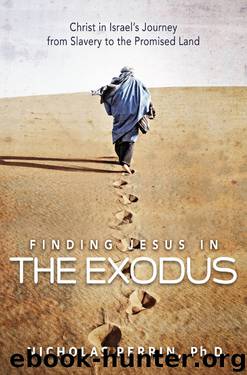Finding Jesus in the Exodus: Christ in Israel's Journey From Slavery to the Promised Land by Nicholas Perrin

Author:Nicholas Perrin [Perrin, Nicholas]
Language: eng
Format: epub
Tags: Religion, Biblical Studies, Prophecy, Old Testament, Christian Theology, Christology
ISBN: 9781455560684
Google: -nzZoAEACAAJ
Amazon: 1455560685
Barnesnoble: 1455560685
Publisher: FaithWords
Published: 2014-10-06T22:00:00+00:00
Healing of the Paralytic
In another story, Jesus is teaching in a crowded home when four men, hoping to find healing for their paralyzed friend, discover that they are unable to access Jesus on account of the crowd. Undeterred, the four men climb up to the roof, carve out a hole through the beams, and then plunk the paralytic down in front of Jesus (Mark 2:1–4). Impressed with their faith, Jesus declares that the paralytic’s sins are forgiven. The scribes on the scene, however, are less impressed; in fact, they are particularly unimpressed with Jesus and his blasphemous presumption in forgiving sins. Aware of the scribes’ internal response, Jesus confronts his skeptics with a rhetorical question: “Which is easier? To say to the paralytic, ‘Your sins are forgiven,’ or to say, ‘Stand up and take up your mat and walk’? But in order that you might know that the Son of Man has authority to forgive sins on earth…” (Mark 2:9–10). Jesus then instructs the paralytic to walk, and the man gleefully complies and goes home.
In considering Jesus’ command to the paralytic, we should notice Jesus’ choice of phrase, “But in order that you might know [hina de eidēte],” a phrase that recurs with minor variation in the Exodus account. In anticipation of the very first plague, right before Aaron strikes the waters with his staff, Moses conveys Yahweh’s message to Pharaoh: “By this you will know that I am the Lord” (Exodus 7:17). Later, after the second plague, Moses agrees to pray for the removal of the frogs “in order that you might know” (LXX: hina eidēs) that none is like Yahweh (Exodus 8:10). In subsequent confrontations with Pharaoh, Moses falls back to the exact same wording again and again (Exodus 8:22; 9:14, 29; 10:2; 11:7; 14:4, 18). For Pharaoh, Moses had made his point—ad nauseam: All the plagues were executed for Pharaoh and the Egyptians, “in order that you might know” the Lord. Mark’s Jesus causes the paralytic to rise before the unbelieving scribes for the same purpose: “in order that you might know” the Lord.
The strange coming together of liberation and conflict in Jesus’ story must have been a powerful lesson for folks back in Rome. Maybe some there had heard about Jesus and believed but never dreamed even in their worst nightmares that this belief would cause them such trouble. Now that naming Christ comes with a sizable cost, the Roman Christians need help in orienting themselves amidst all the confusion. Leveraging Jesus’ example, Mark’s message is simple: We should not be surprised by opposition to this gospel of liberation. Indeed, we should expect it and plan accordingly. To follow in Jesus’ footsteps is to follow a path of unmitigated conflict. Of course, many parts of the world today know this full well. In the West, given recent shifts in the culture, I believe we also are now coming to new terms with this jarring truth.
Download
This site does not store any files on its server. We only index and link to content provided by other sites. Please contact the content providers to delete copyright contents if any and email us, we'll remove relevant links or contents immediately.
Signature in the Cell: DNA and the Evidence for Intelligent Design by Stephen C. Meyer(2515)
Real Sex by Lauren F. Winner(2498)
The Holy Spirit by Billy Graham(2445)
The Secret Power of Speaking God's Word by Joyce Meyer(2268)
The Gnostic Gospels by Pagels Elaine(2048)
Devil, The by Almond Philip C(1913)
Jesus by Paul Johnson(1902)
23:27 by H. L. Roberts(1899)
The Nativity by Geza Vermes(1859)
All Things New by John Eldredge(1792)
Chosen by God by R. C. Sproul(1778)
Angels of God: The Bible, the Church and the Heavenly Hosts by Mike Aquilina(1638)
The Return of the Gods by Erich von Daniken(1583)
Angels by Billy Graham(1560)
Evidence of the Afterlife by Jeffrey Long(1470)
Knowing God by J.I. Packer(1440)
The Gnostic Gospel of St. Thomas by Tau Malachi(1420)
Victorian Sensation by James A. Secord(1413)
How To Be Born Again by Billy Graham(1413)
